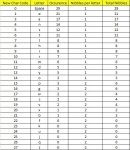Jeremy Leach
Senior Member
I wondered if an 08M could recite some Shakespeare (as you do), so here's a simple attempt  ...
...
I've only syntax checked it and it might be something that could be output to an LCD, perhaps a word at a time?
As it stands there are spare bytes to do 'something else' but not sure what ...perhaps accompanying sound?! I guess it really needs a dramatic YouTube clip ...
I was actually thinking about text compression and got side-tracked !
Code:
#picaxe 08m
eeprom 0,("All the world's a stage,And all the men and women merely players,They have their exits and their entrances,And one man in his time plays many parts,His acts being seven ages.")
For b0 = 0 to 177
Read b0,b1
If b1 = "," Then
SerTxd (CR,LF)
Else
Sertxd(b1)
Endif
Pause 10
NextAs it stands there are spare bytes to do 'something else' but not sure what ...perhaps accompanying sound?! I guess it really needs a dramatic YouTube clip ...
I was actually thinking about text compression and got side-tracked !

